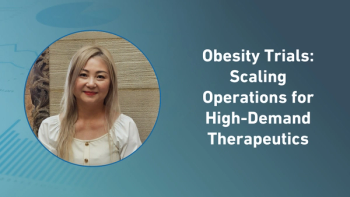
Investigational Gene Therapy Produces Significant Hearing Improvements in Children Born with Profound Genetic Deafness
Cell-selective, adeno-associated virus gene therapy DB-OTO restored hearing to normal levels within 24 weeks in a child born with profound genetic deafness due to variants of the otoferlin gene.
In the Phase I/II CHORD trial (NCT05788536), a novel gene therapy was found to restore hearing to normal levels in a child born with profound genetic deafness. Regeneron Pharmaceuticals, Inc’s cell-selective, adeno-associated virus gene therapy, DB-OTO, improved hearing to normal levels within 24 weeks in a child dosed at 11 months of age, who was one of the youngest patients ever to receive a gene therapy for genetic deafness.1
Further, a child dosed at 4 years of age experienced initial hearing improvements at a six-week assessment. Both patients’ genetic deafness is attributed to variants in the otoferlin gene, which inhibits production of the OTOF protein that plays a key role in communication between sensory cells of the inner ear and the auditory nerve.
“The opportunity of providing the full complexity and spectrum of sound in children born with profound genetic deafness is a phenomenon I did not expect to see in my lifetime,” clinical trial investigator Lawrence R. Lustig, MD, chair of Columbia University’s Department of Otolaryngology – Head & Neck Surgery, said in a press release. “These impressive results showcase the revolutionary promise of DB-OTO as a potential treatment for otoferlin-related deafness, and we are excited to see how this translates into an individual’s development, especially since early intervention is associated with better outcomes for speech development.”1
Congenital deafness impacts approximately 1.7 out of every 1,000 children born in the United States. Nearly half of congenital deafness cases have genetic causes; however, otoferlin-related hearing loss is considered an ultra-rare condition.1
Between 1% and 8% of congenital, nonsyndromic hearing loss cases are attributed to sequence variations in OTOF, which is the primary cause of auditory neuropathy spectrum disorders, according to a study published by Human Genetics.2
“Also known as DFNB9, otoferlin-related hearing loss follows an autosomal recessive inheritance pattern and typically presents as severe-to-profound sensorineural hearing loss with congenital or prelingual onset,” the study authors wrote.2
The use of hearing aids and cochlear implants can amplify sound and improve hearing for those with a range of hearing loss; however, they are not currently able to restore the full spectrum of sound.
The first-in-human, multicenter, open-label CHORD trial analyzed the safety, tolerability, and preliminary efficacy of DB-OTO in infants, children, and adolescents with otoferlin variants. The trial is currently enrolling children under 18 years of age across sites in the United States, United Kingdom, and Spain.
In the two-part trial, those enrolled in the initial dose-escalation cohort will receive a single intracochlear injection of DB-OTO in one ear, whereas the expansion cohort will receive simultaneous single intracochlear injections of DB-OTO in both ears at the selected dose determined from the dose-escalation cohort. Investigators are evaluating hearing improvements via pure tone audiometry (PTA) and auditory brainstem response.
In the children who experienced significant hearing improvements, both received a single intracochlear injection of DB-OTO in one ear with a surgical procedure that involves the same approach that is used for cochlear implants.
The first participant administered DB-OTO in the trial, who was 16 months of age at the 24-week assessment, experienced a hearing improvement to normal levels across key speech frequencies, showing an average 84 dB improvement from baseline. Across all tested frequencies, investigators reported an average 80 dB improvement. Findings for the second participant dosed in the trial, who was 4 years of age at the six-week assessment, were consistent with the first participant at the same timepoint.
The patients experienced an initial improvement in hearing with responses to loud sounds, which was reported across key speech frequencies at an average 19 dB improvement from baseline, with one frequency measure achieving 80 dB in hearing level per PTA. Investigators observed an average 16 dB improvement from baseline across all tested frequencies.
The surgical procedure and the gene therapy were well tolerated, with no adverse events (AEs) or serious AEs reported. The FDA has previously granted DB-OTO with Orphan Drug, Rare Pediatric Disease, and Fast Track designations. Investigators are currently analyzing its potential use in patients with otoferlin-related hearing loss, with safety and efficacy yet to be evaluated by any regulatory authority.
“With the DB-OTO CHORD trial now enrolling participants in sites across the US and Europe, we’re part of the beginning of a new era of gene therapy research that looks to create treatment options that address the root cause of profound genetic deafness,” Lustig added in the release.1
References
1. Latest DB-OTO results show dramatically improved hearing to normal levels in a child with profound genetic deafness within 24 weeks and initial hearing improvements in a second child at 6 weeks. News release. Regeneron. May 8, 2024. Accessed May 8, 2024.
2. Ford CL, Riggs WJ, Quigley T, Keifer OP Jr, Whitton JP, Valayannopoulos V. The natural history, clinical outcomes, and genotype-phenotype relationship of otoferlin-related hearing loss: a systematic, quantitative literature review. Hum Genet. 2023 Oct;142(10):1429-1449. doi: 10.1007/s00439-023-02595-5. Epub 2023 Sep 7. PMID: 37679651; PMCID: PMC10511631.
Newsletter
Stay current in clinical research with Applied Clinical Trials, providing expert insights, regulatory updates, and practical strategies for successful clinical trial design and execution.






.png)



.png)



.png)
.png)
